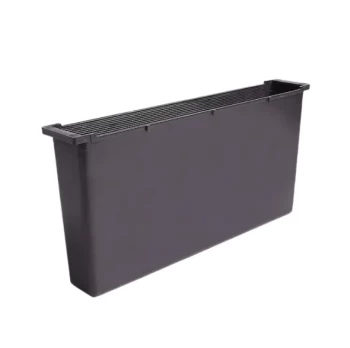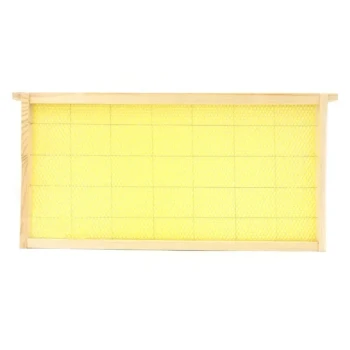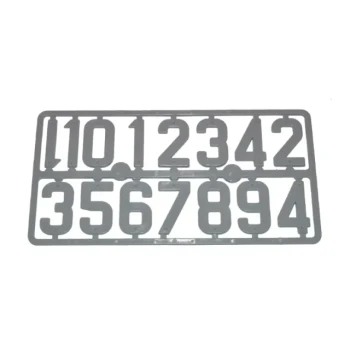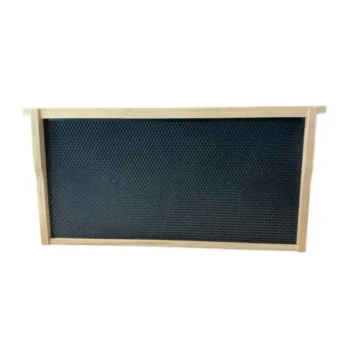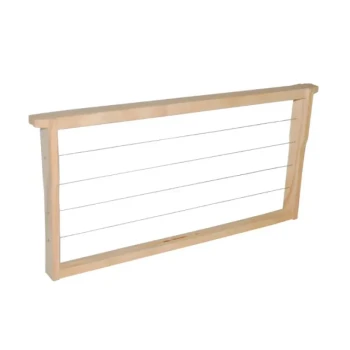Yes, in most cases, you can keep a bee hive in your backyard. Successfully and responsibly keeping bees in a residential setting is entirely achievable, even in smaller gardens. It hinges less on the amount of space you have and more on careful planning, understanding bee behavior, and a commitment to being a good neighbor.
Successful backyard beekeeping isn't about having a huge property; it's about responsible management. The key is understanding your local regulations, communicating with neighbors, and strategically placing the hive to ensure safety and harmony for both bees and people.
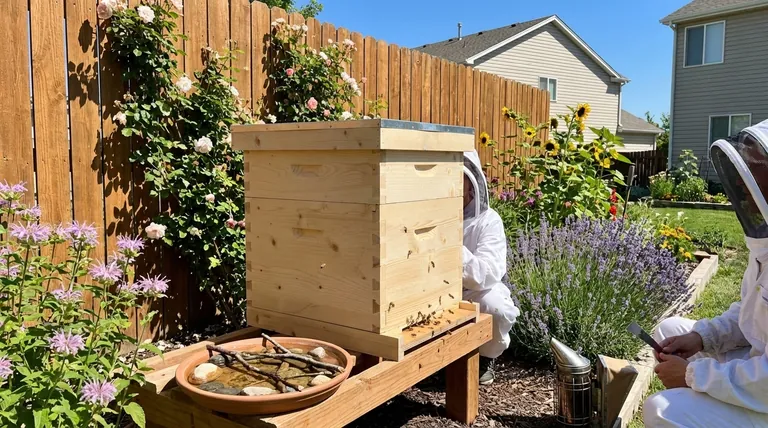
Before You Start: The Non-Negotiable Checklist
Before you purchase any equipment or bees, a few foundational steps are critical. Getting these right will prevent nearly all common problems associated with urban and suburban beekeeping.
Verify Local Ordinances First
This is the most important first step. While many areas welcome beekeepers, rules are highly localized.
Check with your city, county, and even your Homeowner's Association (HOA). They may have specific regulations regarding the number of hives allowed, required distance from property lines (setbacks), or mandatory hive registration.
Assess Your Space Realistically
You don't need a large garden, but you do need the right kind of space.
The ideal location is one that receives morning sun to warm the hive but may have some afternoon shade in very hot climates. Most importantly, it should be away from high-traffic areas like decks, walkways, and children's play areas.
Talk to Your Neighbors
Proactive communication is the key to maintaining good relationships. Let your immediate neighbors know about your plans before the bees arrive.
Explain the gentle nature of honey bees and their importance for pollination. Many beekeepers find that offering a share of the future honey harvest is a simple and effective way to generate goodwill.
Setting Up for Success: Key Principles
Proper setup ensures your bees will thrive while minimizing their interaction with people. It's about creating a predictable and safe environment.
Position the Hive for Safety
The hive's entrance should face away from your house and neighboring properties, ideally towards a garden or open area.
A crucial technique is to place a barrier about six feet in front of the hive, such as a tall fence, hedge, or trellis. This forces the bees' flight path to go straight up, keeping them well above head height as they fly to and from the hive.
Provide a Consistent Water Source
Bees need water. If you don't provide a reliable source, they will find one—often in a neighbor's swimming pool, birdbath, or dripping air conditioner.
Place a shallow dish of water with stones, marbles, or corks in it near the hive. This gives the bees a safe place to land and drink without drowning, and it keeps them within your yard.
Choose the Right Bees
Not all honey bees are the same. Certain breeds, such as Carniolans and Italians, are known for their docile temperament, making them better suited for backyard environments than more defensive varieties.
Understanding the Realities and Responsibilities
Backyard beekeeping is a rewarding hobby, but it is also a commitment. Understanding the potential challenges is vital for long-term success.
The Commitment of Time and Learning
A bee hive is not a "set it and forget it" project. It requires regular inspections (weekly or bi-weekly during peak season) to monitor for health, manage space, and prevent pests like Varroa mites.
The Possibility of Swarms
Swarming is a natural part of a honey bee colony's reproductive cycle. While it can be alarming to non-beekeepers, a swarm is typically very docile as the bees have no hive to defend.
Good hive management can drastically reduce the likelihood of swarming. Learning to recognize the signs is a key skill for any beekeeper.
The Financial Investment
Be prepared for initial startup costs. You will need to invest in the hive itself, protective gear (veil, suit, gloves), essential tools, and the bees.
How to Proceed Based on Your Situation
Your approach should be tailored to your specific environment and goals.
- If your primary focus is neighborly harmony: Prioritize clear communication and use a tall fence or hedge to direct the bees' flight path safely upwards.
- If you have a small or active yard: Select a location away from main paths and play areas, and ensure a dedicated water source is always available within your property.
- If you are new to beekeeping: Start with just one hive and strongly consider joining a local beekeeping association for invaluable mentorship and support.
Ultimately, keeping bees in your backyard is a deeply rewarding way to connect with the natural world and support your local ecosystem.
Summary Table:
| Key Consideration | Actionable Tip |
|---|---|
| Local Regulations | Check city, county, and HOA rules for hive allowances and setbacks. |
| Neighbor Relations | Communicate plans proactively; offer a share of honey for goodwill. |
| Hive Placement | Face entrance away from traffic; use a 6-foot barrier to direct bee flight path upward. |
| Water Source | Provide a shallow dish with stones to keep bees hydrated and on your property. |
| Bee Breed | Choose docile breeds like Carniolans or Italians for a calmer backyard hive. |
Ready to Start Your Backyard Beekeeping Journey?
HONESTBEE is your trusted partner for all your beekeeping needs. We supply high-quality beekeeping supplies and equipment directly to commercial apiaries and beekeeping equipment distributors through our wholesale-focused operations.
Whether you're a new hobbyist or managing a large-scale operation, we provide the reliable gear you need for success.
Contact HONESTBEE today to discuss your specific requirements and learn how our wholesale solutions can support your beekeeping goals.
Visual Guide
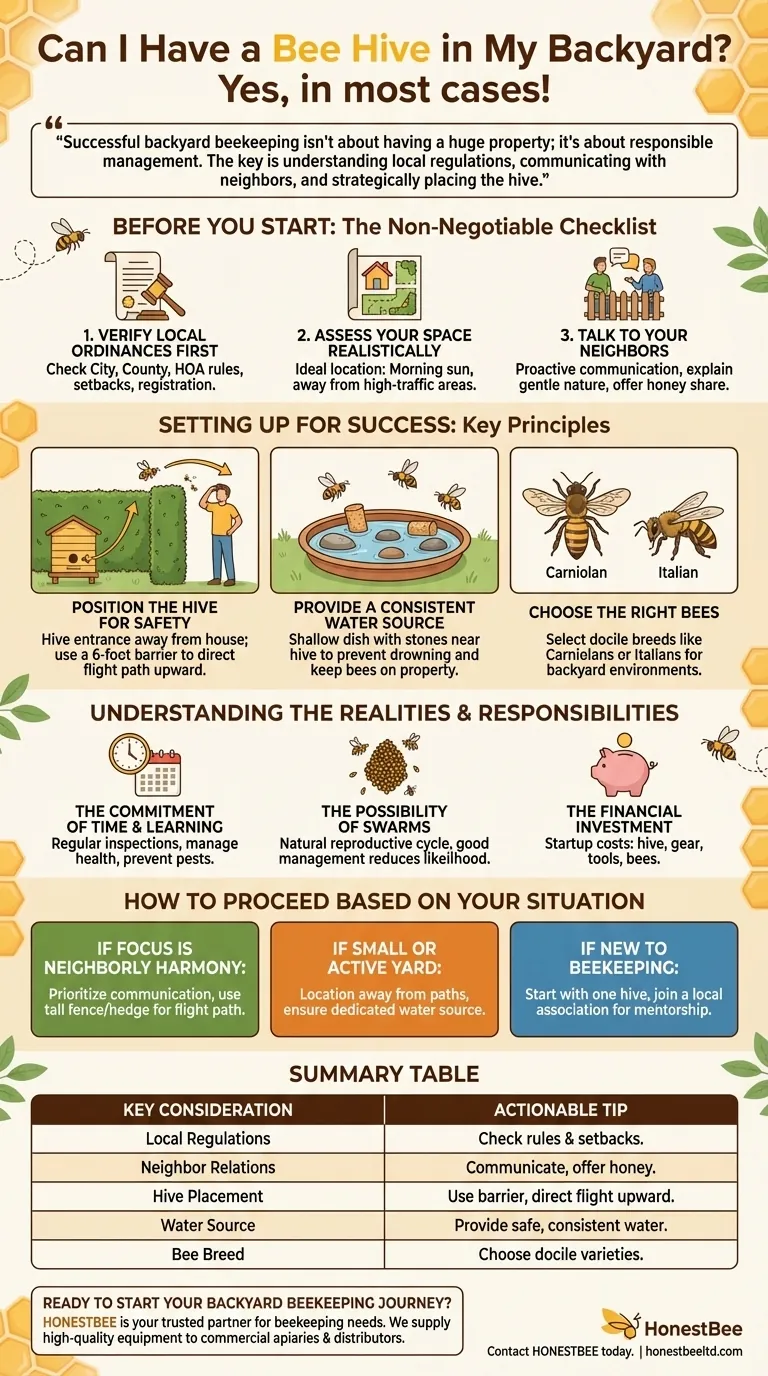
Related Products
- Wholesales Dadant Size Wooden Bee Hives for Beekeeping
- Long Langstroth Style Horizontal Top Bar Hive for Wholesale
- Professional Hive Top Bee Feeder for Beekeeping
- Professional In-Hive Bee Feeder HONESTBEE Frame for Beekeeping
- In-Hive Dual Compartment Frame Bee Feeder for Targeted Colony Nutrition
People Also Ask
- What types of products are available for beekeeping needs? Essential Equipment for Apiaries & Distributors
- What should you do if you find an ant nest near your beehive? Essential Strategies for Hive Protection
- What should beginners consider when purchasing beekeeping equipment? A Guide to Essential Starter Gear
- What are the characteristics of oil-based paint for beehives? Durability vs. Modern Practicality
- How often should the area under beehives be inspected and cleaned during the warm season? A Proactive Maintenance Guide



